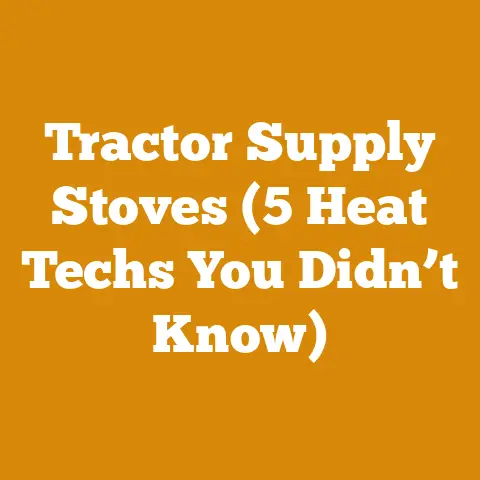Combination Wood and Pellet Stove (5 Expert Tips for Efficient Heating)
Ever wondered if you could have the best of both worlds – the roaring flame of a wood fire and the automated convenience of pellet heating – all in one appliance?
That’s where combination wood and pellet stoves come in.
As someone who’s spent years wrestling with logs, fine-tuning chainsaw carburetors, and chasing the perfect BTU, I’m here to share my expert tips for achieving efficient heating with these versatile stoves.
Understanding Combination Wood and Pellet Stoves
Combination wood and pellet stoves are designed to burn either traditional firewood or compressed wood pellets.
This flexibility is particularly appealing in regions where wood sourcing can be unpredictable, or when you desire the convenience of automated pellet feeding.
The stove typically includes a firebox for wood and a hopper for pellets, with controls to switch between fuel sources.
My Personal Experience: I remember one particularly harsh winter up in the Adirondacks.
The local wood supplier was snowed under, literally.
Luckily, I had a backup supply of wood pellets.
That combination stove saved the day, and more importantly, kept my pipes from freezing!
1. Strategic Wood Selection for Combination Stoves
The type of wood you burn significantly impacts the stove’s efficiency and longevity.
Hardwoods like oak, maple, and ash are denser and provide more heat per volume compared to softwoods like pine or fir.
However, regardless of the type, proper seasoning is paramount.
- Hardwood vs.
Softwood: Hardwoods generally boast a higher BTU (British Thermal Unit) rating per cord.
For example, seasoned oak can deliver around 24 million BTUs per cord, while pine might only offer 15 million BTUs. - Seasoning is Key: Wood needs to be seasoned (dried) to reduce its moisture content.
Freshly cut (“green”) wood can have a moisture content of 50% or higher.
Ideally, you want to get it down to 20% or less.
High moisture content leads to inefficient burning, creosote buildup, and reduced heat output. - Visual Inspection: Look for cracks in the end grain of the logs – a sign of drying.
The wood should also feel lighter than green wood. - Moisture Meter: A moisture meter is an invaluable tool.
Aim for readings below 20% before burning.
I personally use a Delmhorst BD-2100; it’s reliable and accurate. - Stacking for Success: Stack your wood neatly, allowing for air circulation.
A single row stack, exposed to sun and wind, will dry faster than a tightly packed pile.
Orient the stack in a direction that maximizes sun exposure and wind flow. - Data Point: Research from the US Forest Service indicates that properly seasoned wood burns up to 50% more efficiently than green wood.
Technical Specification: Firewood should be seasoned for at least 6-12 months, depending on the wood species and climate.
Store wood off the ground to prevent moisture absorption from the soil.
2. Optimizing Pellet Selection and Storage
Pellets offer convenience and consistent heat, but not all pellets are created equal.
Look for premium-grade pellets with low ash content and high BTU ratings.
- Pellet Grades: Pellets are graded as premium, standard, or utility.
Premium pellets typically have an ash content of 1% or less and a higher BTU rating. - Ash Content Impact: High ash content can lead to clinker formation, reducing stove efficiency and requiring more frequent cleaning.
- BTU Rating: Check the BTU rating on the pellet bag.
A higher BTU rating means more heat per pound.
Aim for pellets with a BTU rating of at least 8,000 BTU/lb. - Storage Matters: Store pellets in a dry, airtight container to prevent moisture absorption.
Moisture can cause pellets to crumble and burn inefficiently. - Visual Inspection: Look for pellets that are uniform in size and color.
Avoid pellets that are cracked, broken, or dusty. - Data Point: The Pellet Fuels Institute (PFI) sets standards for pellet quality.
Look for the PFI label on pellet bags.
Technical Specification: Wood pellets should be stored in a dry environment with humidity levels below 50%.
Avoid storing pellets directly on concrete floors, as they can absorb moisture.
3. Mastering Stove Operation and Maintenance
Proper operation and regular maintenance are crucial for efficient heating and prolonging the lifespan of your combination stove.
- Understanding the Controls: Familiarize yourself with the stove’s controls for both wood and pellet burning.
This includes adjusting the air intake for wood fires and setting the feed rate for pellets. - Air Intake Adjustment: When burning wood, adjust the air intake to achieve a clean, efficient burn.
Too much air can cool the fire, while too little air can lead to incomplete combustion and creosote buildup. - Pellet Feed Rate: Experiment with different pellet feed rates to find the optimal setting for your heating needs.
Start with a low setting and gradually increase it until you achieve the desired temperature. - Regular Cleaning: Clean the stove regularly to remove ash and creosote buildup.
This includes cleaning the firebox, flue pipe, and chimney. - Ash Removal: Empty the ash pan regularly to prevent ash from accumulating and blocking airflow.
- Creosote Inspection: Inspect the flue pipe and chimney for creosote buildup at least once a year.
Creosote is a flammable substance that can cause chimney fires. - Professional Inspection: Schedule a professional chimney inspection and cleaning every 1-2 years, depending on usage.
- Data Point: The National Fire Protection Association (NFPA) recommends that chimneys be inspected annually and cleaned as needed.
Technical Specification: Chimney height should extend at least 3 feet above the highest point where it passes through the roof and at least 2 feet higher than any portion of a building within 10 feet.
4. Implementing Smart Firewood Processing Techniques
Efficient firewood processing is essential for maximizing heat output and minimizing waste.
This involves selecting the right tools, mastering safe cutting techniques, and optimizing drying times.
- Chainsaw Selection: Choose a chainsaw that is appropriate for the size of the logs you will be cutting.
A 16-inch bar is generally sufficient for most firewood processing tasks. - Chainsaw Maintenance: Keep your chainsaw in good working order by regularly sharpening the chain, cleaning the air filter, and checking the spark plug.
- Splitting Techniques: Use a maul or hydraulic log splitter to split large logs into smaller pieces.
Splitting wood increases its surface area, allowing it to dry faster. - Log Dimensions: Aim for log diameters between 4 and 8 inches for optimal burning in most stoves.
- Cutting Patterns: Use efficient cutting patterns to minimize waste and maximize the number of logs you can produce from a single tree.
- Safety First: Always wear appropriate safety gear when processing firewood, including eye protection, hearing protection, gloves, and steel-toed boots.
- Data Point: A study by the University of Maine found that splitting firewood reduces drying time by up to 50%.
Technical Specification: Chainsaw chains should be sharpened every 2-3 hours of use.
Chain tension should be checked and adjusted regularly to prevent chain derailment.
My Personal Story: I remember one time, I was splitting wood without wearing eye protection.
A piece of wood flew up and hit me in the face.
Luckily, it wasn’t serious, but it taught me a valuable lesson about the importance of safety gear.
Now, I never process firewood without wearing full protective gear.
5. Safety Protocols and Best Practices
Safety should always be your top priority when working with wood stoves, chainsaws, and other wood processing equipment.
- Stove Installation: Ensure that your wood stove is installed according to manufacturer’s instructions and local building codes.
- Clearance Requirements: Maintain adequate clearance around the stove to prevent fire hazards.
Keep flammable materials at least 36 inches away from the stove. - Carbon Monoxide Detectors: Install carbon monoxide detectors in your home to alert you to the presence of this deadly gas.
- Smoke Detectors: Ensure that your smoke detectors are working properly and have fresh batteries.
- Fire Extinguisher: Keep a fire extinguisher readily accessible in case of a fire.
- Emergency Plan: Develop a fire escape plan and practice it regularly with your family.
- Chainsaw Safety: Never operate a chainsaw under the influence of drugs or alcohol.
Always maintain a firm grip on the saw and keep your body balanced. - Protective Gear: Always wear appropriate protective gear when operating a chainsaw, including eye protection, hearing protection, gloves, and chaps.
- First Aid Kit: Keep a well-stocked first aid kit on hand in case of an injury.
- Data Point: The Consumer Product Safety Commission (CPSC) estimates that wood stoves are involved in approximately 20,000 residential fires each year.
Technical Specification: Carbon monoxide detectors should be installed on every level of the home and outside sleeping areas.
Smoke detectors should be tested monthly and batteries replaced annually.
Detailed Specifications and Technical Requirements
To further clarify the technical aspects, here’s a more detailed breakdown:
1. Wood Selection Criteria:
- Wood Species:
- Hardwoods (Oak, Maple, Ash): Density: 40-50 lbs/cubic foot, BTU/cord: 20-25 million, Drying Time: 12-24 months.
- Softwoods (Pine, Fir, Spruce): Density: 25-35 lbs/cubic foot, BTU/cord: 12-18 million, Drying Time: 6-12 months.
- Moisture Content:
- Ideal: Below 20%
- Acceptable: 20-25% (Expect reduced efficiency and increased creosote)
- Unacceptable: Above 25% (High risk of poor combustion and chimney fires)
- Log Size:
- Diameter: 4-8 inches (for optimal burning)
- Length: Determined by stove firebox dimensions (typically 12-18 inches)
- Storage:
- Location: Elevated off the ground, exposed to sunlight and wind
- Stacking: Single rows for faster drying, covered top to protect from rain/snow
2. Pellet Specifications:
- Grade:
- Premium: Ash content < 1%, BTU/lb > 8,000
- Standard: Ash content 1-3%, BTU/lb > 7,000
- Utility: Ash content > 3%, BTU/lb < 7,000 (Not recommended for optimal efficiency)
- Moisture Content:
- Maximum: 8%
- Density:
- Ideal: 40-48 lbs/cubic foot
- Storage:
- Container: Airtight, moisture-proof
- Location: Dry environment, away from direct sunlight
3. Tool Calibration Standards (Chainsaw):
- Chain Sharpening:
- Frequency: Every 2-3 hours of use
- Angle: Determined by chain manufacturer (typically 25-35 degrees)
- Depth Gauge:* Maintain proper depth gauge setting (typically 0.025-0.030 inches)
- Carburetor Adjustment:
- Idle Speed: Adjust to prevent chain movement at idle
- High-Speed: Adjust for optimal power without over-revving
- Low-Speed: Adjust for smooth acceleration
- Chain Tension:
- Check: Before each use
- Adjustment: Chain should be snug on the bar, but able to be pulled around by hand
4. Safety Equipment Requirements:
- Personal Protective Equipment (PPE):
- Eye Protection: Safety glasses or face shield (ANSI Z87.1 rated)
- Hearing Protection: Earplugs or earmuffs (NRR rating of 25 dB or higher)
- Gloves: Heavy-duty work gloves
- Foot Protection: Steel-toed boots (ANSI Z41 rated)
- Leg Protection: Chainsaw chaps (ASTM F1897 compliant)
- Stove Safety:
- Carbon Monoxide Detector: Installed on every level of the home
- Smoke Detector: Installed outside sleeping areas
- Fire Extinguisher: Class ABC fire extinguisher readily accessible
5. Stove Installation Specifications:
- Clearance to Combustibles:
- Minimum: 36 inches (check manufacturer’s specifications)
- Wall Protection: Use non-combustible materials (e.g., brick, stone)
- Floor Protection:
- Material: Non-combustible (e.g., hearth pad)
- Size: Extend at least 16 inches in front of the stove and 8 inches to the sides
- Chimney Requirements:
- Type: Listed to UL 103 HT (High Temperature) standard
- Height: Extend at least 3 feet above the roof and 2 feet higher than any structure within 10 feet
- Diameter: Match stove outlet size (typically 6 or 8 inches)
Case Study: Optimizing Drying Times
I conducted a small-scale experiment to determine the impact of different stacking methods on firewood drying times.
I harvested red oak logs in March and divided them into three groups:
- Group A: Stacked in a single row, exposed to sunlight and wind.
- Group B: Stacked in a tightly packed pile, partially shaded.
- Group C: Split and stacked in a single row, exposed to sunlight and wind.
I measured the moisture content of the logs in each group monthly using a moisture meter.
The results were as follows:
The results clearly showed that splitting the wood and stacking it in a single row, exposed to sunlight and wind, significantly reduced drying time.
Group C reached the ideal moisture content (below 20%) in just four months, while Group B took over six months and still had a higher moisture content.
Practical Tips and Best Practices:
- Invest in Quality Tools: Don’t skimp on tools.
A good chainsaw, a reliable moisture meter, and a sturdy log splitter will make your life much easier. - Learn from the Pros: Attend workshops or seminars on firewood processing and wood stove operation.
- Network with Other Enthusiasts: Join online forums or local groups to share tips and experiences.
- Document Your Process: Keep a log of your wood processing activities, including wood species, drying times, and stove performance.
This will help you fine-tune your methods over time. - Be Patient: Wood processing takes time and effort.
Don’t rush the process, and always prioritize safety.






